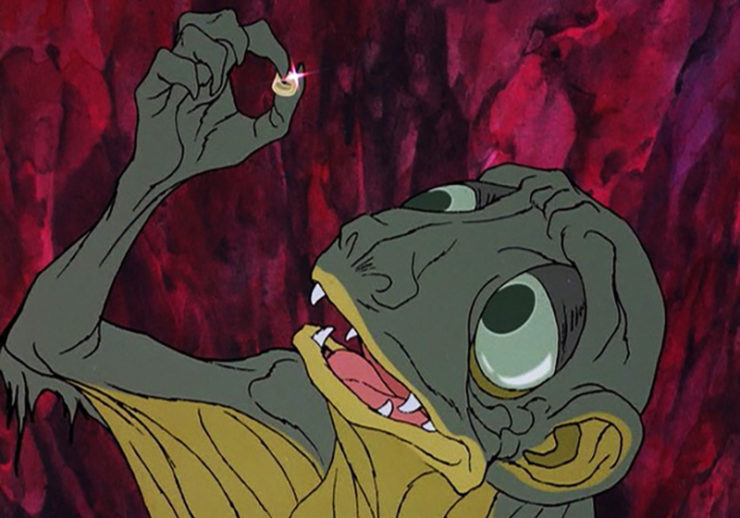Watched all in a row, the animated movies The Hobbit, The Lord of the Rings, and The Return of the King form their own peculiar Tolkien trilogy. Granted, they’re movies made by two different studios with two different styles, and they don’t really align storywise, and one was a feature film while the other two were TV movies. But all together, they form a vaguely coherent story of the One Ring, from its finding by Bilbo to its destruction by Frodo and Gollum. It’s almost fitting, really, given the wildly divergent versions of the Germanic myths and legends that inspired Tolkien in the first place. If The Lord of the Rings really were an ancient tale handed down over centuries, as this movie proposes in its gobsmackingly weird final moments (we’ll get to that), it would likely resemble the animated trilogy more than any other version.
That’s not to say all those versions are equally good. Rankin-Bass’s 1977 The Hobbit (previously discussed here) and Ralph Bakshi’s 1978 The Lord of the Rings (covered in Part I and Part II here) are both masterpieces. The Rankin-Bass 1980 TV movie follow-up to those movies is… not. In fairness, Rankin-Bass had a task almost as impossible as Frodo’s: How do you make a stand-alone Return of the King movie that is both a direct sequel to your own The Hobbit and an unofficial, quasi-sequel to Bakshi’s Lord of the Rings? The answer is: awkwardly.
The film opens with a foreboding narration by John Huston, who returns from The Hobbit as the voice of Gandalf (Orson Bean similarly reprises his voice work as Bilbo, plus Frodo, and Brother Theodore once again voices Gollum). Gandalf asks that you “concern yourself with wizards,” which sounds like an unsuccessful pick-up line you’d overhear at Comic-Con. He tries to set the tone for the movie by speaking of “cosmic metamorphosis” and “festering malignancy,” though it mostly makes me think he’d spent the years since The Hobbit holed up in Minas Tirith’s archives memorizing an SAT prep book.
We then cut to Rivendell and Bilbo’s 129th Birthday. Elrond is back, looking like a space-vampire once again, and also attending are Gandalf, Frodo, Merry, Pippin, and Sam. Bilbo is very old and keeps nodding off before anyone can eat the cake. In between naps, he confesses confusion as to what happened to the ring he gave Frodo and also why Frodo is missing a finger. But have no fear, the Minstrel of Gondor is here! And he, his lyre, and his utterly enormous nose (he can probably smell Mount Doom from there) are going to sing a series of songs to fill in Bilbo and everyone else who didn’t see Bakshi’s film.
The opening is a fairly clever adaptation trick. The Fellowship of the Ring opens with Bilbo’s 111th birthday party, after all, so it’s fitting to use Bilbo’s birthday as a frame story. I could have done without the Minstrel, though, who looks like he wandered in from a Terry Gilliam animation.
The actual story starts where Sam and Frodo’s story starts in the book. Frodo’s been captured by orcs and imprisoned in the Tower of Cirith Ungol on the border of Mordor. Samwise is left outside and now has the Ring and the sword Sting in his possession. Samwise says Frodo was captured in a “battle,” and though he walks through a reeking, cobwebbed tunnel, Shelob, the last child of Ungoliant, doesn’t bother to trouble this particular unhappy world.
Roddy McDowall gives Samwise his voice and though he’s a fine actor, his sharp voice and tough tone seem out of sorts for Old Sam. He’s less buffoonish than Bakshi’s take on the character, but he lacks the soulful grit and goodness that Sean Astin brings to the role in Peter Jackson’s films.
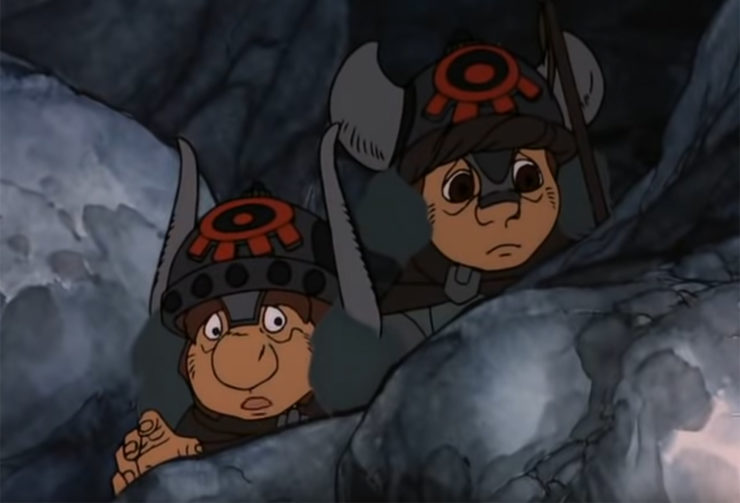
That tough tone does suit the one truly outstanding moment in this movie, one that is unique in the nine Middle-earth films that have been produced to date: we get a detailed vision of what would happen if Samwise claimed the One Ring. Jackson’s Fellowship gave us a DayGlo, windy Cate Blanchett with a baritone voice to show us what she’d be like if she took the Ring. But we don’t really get to see what she’d do with it. The Return of the King shows us the full vision: Samwise crosses into Mordor and suddenly feels the Ring’s call. He grips it, glows red, and dreams of becoming “Samwise the Strong,” leading an army against Barad-dûr and then turning Mordor into a “garden of delight”—and the orcs into lemurs, for some reason. It’s a great scene, underlining not only the power the Ring offers, but Sam’s character. Even were he to gain godlike power to command others, he’d ultimately still be a gardener (of course, the vision is a lie the Ring tells. Sam would never be strong enough to wield the Ring; nor does its power lead to gardens of delight. The power it wields is ultimately corrupting and destructive. It can make a Mordor, nothing more).
And it’s that character that allows him to resist the Ring, and tells us a great deal about hobbits’ remarkable resistance to its power. Sam wouldn’t want to make others build a garden; he’d want to do it himself, get his hands dirty, and then sit in a rocking chair and watch his children play. That’s his ambition. It’s not rustic simplicity, or not only that. It’s that commitment to careful craft, and to nurturing, that makes the hobbits less susceptible to the Ring’s temptation.
(The scene also made me finally realize why Tom Bombadil is so unaffected by the Ring. He’s more or less a hobbit himself, in character—only a hobbit with an ancient and divine nature. He has both the temperament and the inherent power to not give a fig about the Ring. And perhaps the reason the hobbits eventually settled in Bree and the Shire was because they were unconsciously drawn towards Bombadil’s little country. The Elves had the Valar and Maiar; the Dwarves had Aulë the Smith; Men had the Istari; maybe the patron spirit of the hobbits is that merry fellow with the yellow boots?)
Once Sam rejects the Ring, he realizes he probably ought to save Frodo from the Orcs. He even declares, “Frodo Lives!” echoing the famous graffiti that popped up back when Tolkien was mostly a countercultural phenomenon.
Cirith Ungol is beautifully realized, a tower hewn into the side of a mountain. And the vulture-like Watcher statues that guard it are suitably creepy. Sam manages to get past the watchers thanks to a mysterious, sparkling phial he finds in his sleeve. After being rescued, Frodo rather hilariously reveals it’s the “Phial of Galadriel,” but he’s not allowed to say more or it will lose its power. Maybe Rankin-Bass couldn’t afford the rights to Galadriel beyond this one mention…
Frodo and Sam don some Orc armor and set off across Mordor. Rankin-Bass wisely focus most of the movie’s running time on this plot. It’s easier on the budget, for one, and it’s a simple story about two dudes trying to climb a volcano. You don’t need a lot of set-up. The stakes and characters are obvious. The Gondor portion of the film is much more difficult because you have so many plotlines and characters that should be coming together: Denethor and Faramir! Aragorn and Legolas and Gimli and the Army of the Dead! Merry and Dernhelm/Éowyn and the Riders of Rohan! Prince Imrahil!
But The Return of the King cuts almost all of them. Denethor burns himself alive after one scene—which is pretty intense for an animated TV movie. Gimli and Legolas apparently went home after the Battle of Helm’s Deep. Faramir doesn’t appear in the movie, except in a possible cameo during Aragorn’s procession, riding next to Éowyn. Speaking of Aragorn, the title character doesn’t even appear until there about fifteen minutes left in the movie, leading the Black Fleet. How he got there, why he’s the heir to the throne of Gondor, why he doesn’t seem to know about Frodo—none of this is ever explained. He just sort of shows up, presumably because you can’t call a movie The Return of the King without a king returning.
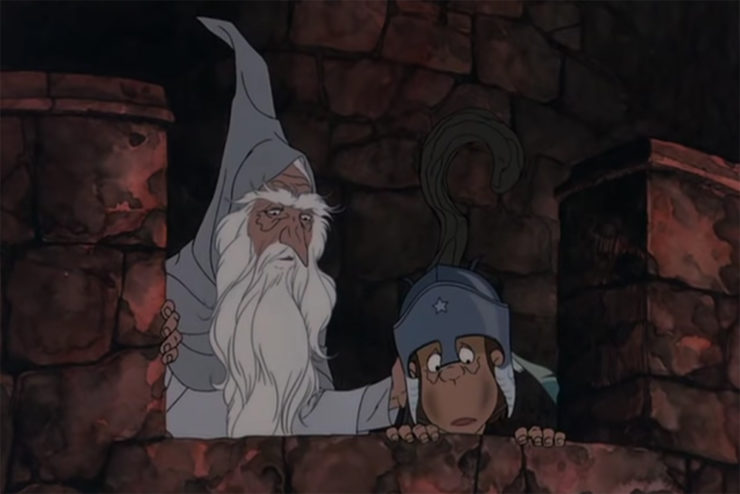
Gandalf and Pippin are the main focus of the Gondor part of the story, which would be fine except that Pippin looks and sounds like the wacky kid sidekick in an ‘80s sitcom. I kept waiting for him to drop a catchphrase like, “Boy, I’m a fool of a Took!” followed by canned laughter. With Denethor having already toasted himself, Pippin’s mostly there to rally a despairing Gandalf to fight (which is a real betrayal of Gandalf’s spirit of heartening and encouragement in the book). They face down the Witch-king of Angmar at the gates of Minas Tirith. Now, I should add that while eight of the nine Nazgûl are skeletons with beautiful heads of white hair riding on flying horses, the Witch-king is more traditionally invisible. Unfortunately, he also talks like Darth Vader crossed with a teacher in a Peanuts cartoon. It’s…not very intimidating.
But then the Riders of Rohan show up, and turn the tide, until King Théoden is tragically murdered by a cloud. Yes, that’s right. Théoden isn’t killed by the Witch-king, but by a sudden darkness that covers the land.
The Witch-king does finally appear, riding a decently dragonish fell beast rather than a Pegasus. Why he descends into a circle of his enemies when Théoden is already dead is a mystery. But suddenly, Éowyn rides to challenge him, revealing that she is both a woman and a character in this movie all in the same moment. It’s left for Merry to explain to Pippin (and the audience) that she’s Théoden’s niece but was forbidden to ride into battle with him. The sudden reveal completely drains the emotion and significance from the moment. This is one of the defining moments in The Lord of the Rings, but here it arrives not like an emotional climax to a compelling character arc, but like a “Hey, remember that time…?” moment in an episode of Family Guy.
Buy the Book
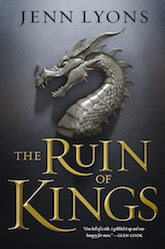

The Ruin of Kings
Meanwhile, back in Mordor, Frodo and Sam are discovered by Orcs and pressed into a march. And here we get the absolute highlight of the movie: WHERE THERE’S A WHIP THERE’S A WAY. Most of the film’s songs are boring and overly repetitive, but “Where There’s a Whip, There’s a Way” absolutely slaps, as the kids say. I’ve been humming it for days. It also does a good job of humanizing the Orcs. “We don’t wanna go to war today,” they sing, but they don’t have a choice. It’s like “Manic Monday,” but about covering all the lands in a second darkness.
Frodo and Sam’s battalion reaches a crossroads where they’re stopped by an army of evil men who insist on going first, saying, “Men come before Orcs.” It’s a nice tweak from the books where two Orc armies run into each other and begin fighting. Sam, perhaps still carrying some of the influence of the Ring, manages to goad the Orc captain into attacking the Men. Frodo and Sam escape in the subsequent scuffle, thus dooming the realm of Sauron. In most versions of the story, including the book, Sauron’s fatal folly is believing that the Ring would quickly corrupt any who found it. That’s here, too, but there’s also the clear theme that a power based on prejudice, cruelty, and force will eventually eat itself.
When Sam and Frodo finally do make it to Mount Doom, they’re attacked by Gollum, who is back on his precious bullshit (and also back to looking like a horrible frog monster). Rankin-Bass’s amphibian Gollum worked well in The Hobbit, where he’s a subterranean horror. As a corrupted, twisted hobbit, though, this froggy Gollum doesn’t work at all. Gollum should be the ultimate manifestation of the Ring’s power and corruption, a vision of the Ring’s decay of mind and body. Instead, he’s just a plot device. And that undercuts the horror of the next scene, where Frodo does succumb to the call of the precious and claims it. As if attempting to give the moment more punch, Gandalf’s narration attributes Frodo’s taking of the Ring to Théodeon’s death in Gondor. It’d be an effective tack if Théodeon’s death had any emotional resonance in the film.
The obvious timeline problems this version of events presents is handwaved away with the mention that Samwise searched for Frodo inside Mount Doom for “days,” which seems like an awful long time to wander around inside a volcano looking for an invisible dude. Sauron also apparently didn’t notice, or else decided he’d take care of it later. Maybe it was procrastination that ultimately defeated the Dark Lord.
In the meantime, Aragorn leads an army to the Black Gate where they briefly argue with a snotty Mouth of Sauron. We’ll talk more about this when we reach Peter Jackson’s Return of the King, but comparing Rankin-Bass’s Mouth of Sauron to Jackson’s shows how a faithful adaptation of a character isn’t necessarily the best or most truthful. This Mouth of Sauron is straight from the book, but he’s also not especially memorable. He taunts, sniffs, and leaves.
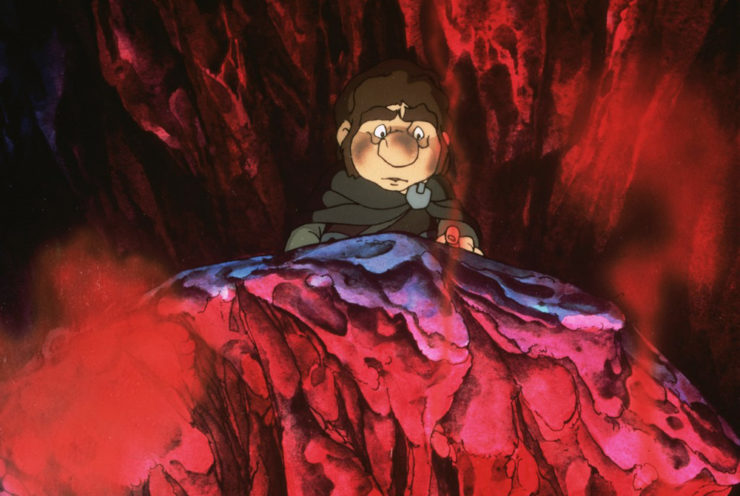
Samwise does finally find Frodo grappling with Gollum and the film’s big mystery—WHY DOES FRODO ONLY HAVE NINE FINGERS?—is finally resolved when Gollum bites one off. You know the rest: dance of joy, slip, fall, “precious!”, lava, end of the Third Age of Middle-earth.
The fall of Mordor is appropriately apocalyptic. The Eagles come and ferry away not only Frodo and Sam, but the entire army of Gondor. It’s a callback to the rather grim ending of the Battle of the Five Armies in Rankin-Bass’s The Hobbit.
Back in Rivendell, the Minstrel of Gondor wraps up his song. Bilbo’s fallen asleep, which is honestly a more devastating critique of this version of The Return of the King than I can offer. Gandalf then reveals that he and Elrond are going to sail into the West and Frodo asks to come along. He is weary of the world, and also presumably feeling guilty about inadvertently killing the King of Rohan by putting on the Ring.
Before sailing into the West, Frodo gives the Red Book of Westmarch to Samwise. Sam then asks a good question: What’s to become of hobbits in this new Age of Men? Gandalf’s answer to is note that hobbits are related to Men (yes), that Frodo is taller than Bilbo (okay), that Pippin is taller than Frodo (uh huh), and that eventually hobbits will simply become Men (wait, WHAT?).
Leave it to Rankin-Bass to end their movie with the single weirdest spin in the entirety of the Middle-earth Movie canon. Gandalf then adds that people in the future who hear the story of the War of the Ring may themselves wonder if they’ve got hobbit blood in them.
On the one hand, yes, this fits Tolkien’s view that hobbits are a branch of Men. On the other, Tolkien didn’t foresee hobbits becoming Men; in fact, he saw them becoming smaller over the ages, eventually becoming a dwindling, hidden people and the “inspiration” behind little people like brownies and sprites in English folklore.
Then again, this conceit does a nice job of making this fantasy seem more real, more like an actual history as Tolkien intended. I like to imagine a young, movie-loving man in New Zealand watching that scene, and thinking, his curiosity piqued, “Why, yes, maybe I do have some hobbit in me!” And twenty years later, that man would transform the cinematic Middle-earth from a half-forgotten cultural curiosity into a massive pop culture juggernaut.
Next time, we’ll take a look at the greatest Middle-earth movie yet made, Peter Jackson’s The Lord of the Rings: The Fellowship of the Ring.
Austin Gilkeson formerly served as The Toast‘s Tolkien Correspondent, and his writing has also appeared at Catapult and Cast of Wonders. He lives outside Chicago with his wife and son.










